
15 Andromedae, abbreviated 15 And, is a single, variable star in the northern constellation of Andromeda. 15 Andromedae is the Flamsteed designation, while its variable star designation is V340 And. Its apparent visual magnitude is 5.55, which indicates it is faintly visible to the naked eye. Its estimated distance from the Earth is 252 light years, and it is moving further away with a heliocentric radial velocity of 13 km/s.
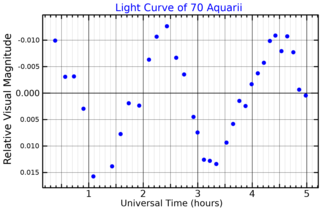
70 Aquarii is a variable star located 425 light years away from the Sun in the equatorial constellation of Aquarius. It has the variable star designation FM Aquarii; 70 Aquarii is the Flamsteed designation. It is near the lower limit of visibility to the naked eye, appearing as a dim, yellow-white hued star with a baseline apparent visual magnitude of 6.19. This star is moving closer to the Earth with a heliocentric radial velocity of –5.8 km/s.
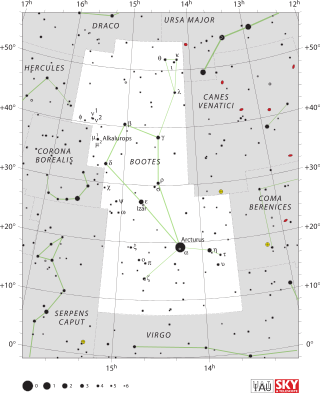
Gamma Boötis, Latinised from γ Boötis, is a binary star system in the northern constellation of Boötes the herdsman, forming the left shoulder of this asterism. The primary component has the proper name Seginus, the traditional name of the Gamma Bootis system. It has a white hue and is visible to the naked eye with a typical apparent visual magnitude of +3.03. Based on parallax measurements obtained during the Hipparcos mission, it is located at a distance of approximately 85 light-years from the Sun, but is drifting closer with a radial velocity of −32 km/s.

Kappa Boötis is a double star in the constellation Boötes. It has the traditional name Asellus Tertius and the Flamsteed designation 17 Boötis. The components are separated by an angular distance of 13.5 arcsec, viewable in a small telescope. Kappa Boötis is approximately 155 light years from Earth.
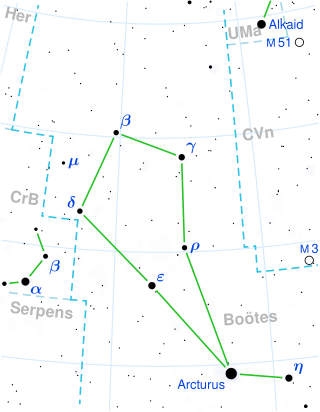
Lambda Boötis, also named Xuange, is a star in the northern constellation of Boötes. Based on parallax measurements, it is approximately 99 light-years from the Sun.

Sigma Boötis, its name Latinized from σ Boötis, is a single star in the northern constellation of Boötes. It has a yellow-white hue and is visible to the naked eye with an apparent visual magnitude of 4.46. Located to the southeast of Rho Boötis, the dwarf Sigma may at first appear as a naked-eye double, but the angular proximity with Rho is merely line-of-sight. Sigma Boötis is located at a distance of 51.1 light years from the Sun based on parallax. The star has a relatively high proper motion and is traversing the sky at the rate of 0.230″ yr−1.
50 Cancri is a single star in the zodiac constellation of Cancer, located 183 light years away from the Sun. It has the Bayer designation A2 Cancri; 50 Cancri is the Flamsteed designation. It is faintly visible to the naked eye as a white-hued star with an apparent visual magnitude of 5.89. The star is moving away from the Earth with a heliocentric radial velocity of 23 km/s, having come to within 118 light-years some 1.2 million years ago.
Lambda Geminorum, Latinized from λ Geminorum, is a candidate multiple star system in the constellation Gemini. It is visible to the naked eye at night with a combined apparent visual magnitude of 3.57. The distance to this system is 101 light years based on parallax, and it is drifting closer with a radial velocity of –7.4 km/s. It is a member of what is suspected to be a trailing tidal tail of the Hyades Stream.

SX Phoenicis is a variable star in the southern constellation Phoenix. With an apparent visual magnitude ranging around 7.33, it is too faint to be readily seen with the naked eye and requires binoculars. It is located 272 light years from the Sun, as determined from an annual parallax shift of 12 mas.

29 Cygni is a single star in the northern constellation of Cygnus. It is dimly visible to the naked eye as a white-hued star with an apparent visual magnitude of 4.93. The distance to 29 Cyg, as estimated from an annual parallax shift of 24.5 mas, is 133 light years. The star is moving closer to the Earth with a heliocentric radial velocity of −17 km/s. It is a member of the 30–50 million year old Argus Association of co-moving stars.

Psi Phoenicis is a star in the constellation Phoenix. Its apparent magnitude varies from 4.3 to 4.5 with a period of about 30 days and it is approximately 342 light years away based on parallax.

ι Phoenicis, Latinized as Iota Phoenicis, is a binary star system in the southern constellation of Phoenix, near the constellation border with Grus. It is visible to the naked eye as a faint, white-hued star with an apparent visual magnitude that fluctuates around 4.71. This system lies approximately 254 light years from the Sun based on parallax, and it is drifting further away with a radial velocity of +19.4 km/s.

λ1 Phoenicis, Latinized as Lambda1 Phoenicis, is a double star in the southern constellation of Phoenix. It is visible to the naked eye as a faint, white-hued point of light with a combined apparent visual magnitude of 4.76. The system is located approximately 183 light years away from the Sun based on parallax. It is a member of the Hyades Supercluster.

Xi Phoenicis, Latinized from ξ Phoenicis, is a visual binary star system in the southern constellation of Phoenix. It is faintly visible to the naked eye, having an apparent visual magnitude of 5.70. Based upon an annual parallax shift of 14.61 mas as measured from Earth, it is located around 223 light years from the Sun. The system is moving away from the Sun with a radial velocity of about +10 km/s.
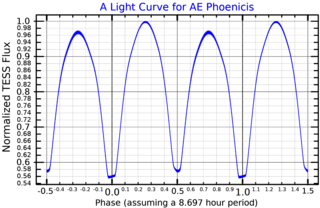
AE Phoenicis is a variable star in the constellation of Phoenix. An eclipsing binary, its apparent magnitude has a maximum of 7.56, dimming to 8.25 during primary eclipse and 8.19 during secondary eclipse. From parallax measurements by the Gaia spacecraft, the system is located at a distance of 168 light-years from Earth.
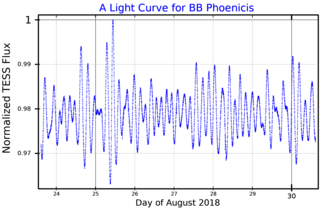
BB Phoenicis is a variable star in the constellation of Phoenix. It has an average visual apparent magnitude of 6.17, being visible to the naked eye with excellent viewing conditions. From parallax measurements by the Gaia spacecraft, it is located at a distance of 448 light-years from Earth. Its absolute magnitude is calculated at 0.6.

AZ Phoenicis is a variable star in the constellation of Phoenix. It has an average visual apparent magnitude of 6.47, so it is at the limit of naked eye visibility. From parallax measurements by the Gaia spacecraft, it is located at a distance of 322 light-years from Earth. Its absolute magnitude is calculated at 1.65.

Rho Phoenicis is a variable star in the constellation of Phoenix. From parallax measurements by the Gaia spacecraft, it is located at a distance of 245 light-years from Earth.

HD 74423 is a heartbeat binary star and one component pulsates on only one hemisphere. This is caused by tidal interaction with its partner. The star is located in the Volans constellation.
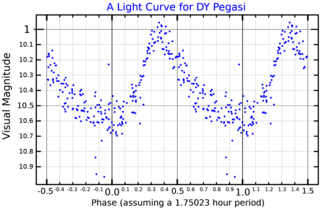
DY Pegasi, abbreviated DY Peg, is a binary star system in the northern constellation of Pegasus. It is a well-studied SX Phoenicis variable star with a brightness that ranges from an apparent visual magnitude of 9.95 down to 10.62 with a period of 1.75 hours. This system is much too faint to be seen with the naked eye, but can be viewed with large binoculars or a telescope. Based on its high space motion and low abundances of heavier elements, it is a population II star system.














